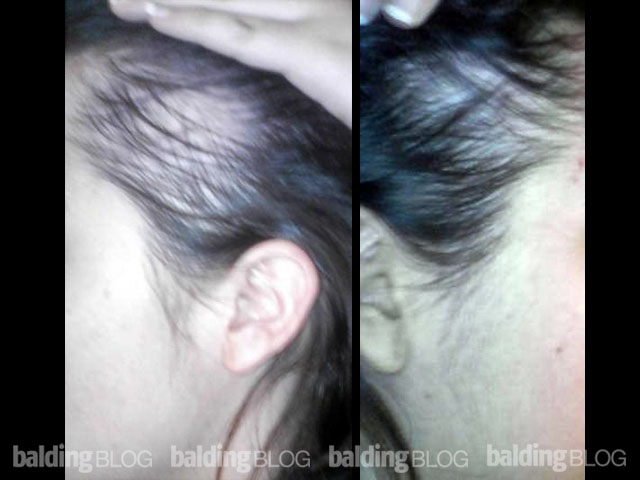Hello – I hope I’m not being redundant with this question but I didn’t see a similar question on your site or on the many others I’ve searched (have also read lots of books). I’m 54, female and am not yet in menopause. About 4 years ago, I noticed that a relatively thick layer of my bangs would no longer grow past my eyebrows. In general, this layer of shorter hair extends to both temples and stops at the front of the ears (although it is obviously most noticeable right in front and makes styling a hassle). I have become much more careful with heat styling and have been taking supplements (Black Currant Oil, Bio Available Silica , EFA’s, Multi-Vitamins, Special Hair Formula Vitamins, Calcium, and have recently adjusted my diet to include salmon, nuts, good fats, etc — and I’ve seen some overall thickening and lengthening.
I recently went to a local dermatologist who is a specialist in hair and he diagnosed me with androgenic alopecia and prescribed rogaine for the small area at the hairline. If I recall correctly, he said I had a brief anagen phase. I show no signs of shedding or thinning and I have a very thick head of fine hairs (I know I’d be an excellent candidate for transplants should I need them!). I asked him about whether I could take birth control pills (low androgen ones) or spirodactone instead of or in addition to the Rogaine (which seems like a mess and hassle — for the rest of my life). He said no no no and wouldn’t run any tests for ferritin, hormonal issues, etc. I would think that the fact that I’m 54 and still menstruating (and have a very large uterine fibroid that’s still being fed by estrogen; I’m being watched by my ob/gyn) would suggest some hormonal atypicality for my age, but what do I know?. Although he was very nice and kind, I’m not 100% confident in his diagnosis because the hair has improved significantly since this problem began. Is it possible that I have a different problem? Could I first try to treat this issue with anti-androgen medications before I sign on for life with Rogaine?
Thank you for time and best wishes.
Your dermatologist is probably correct with his assessment. Many people will have a shorter anagen phase as they age. This means that as hair grows at about 1/2 inch per month, if your anagen phase is shorter (let’s say to the tip of your nose in the front), then you can calculate backwards the length of the anagen cycle by dividing that distance by 1/2 inch.
You should have the battery of tests run, which will rule out other causes of changes in the anagen cycle other than genetic causes. These blood tests include:
- Sex Hormone tests
- SHBG (Sex Hormone Binding Globulin) used to test status of male hormones
- Estradiol is a sex hormone
- FSH (Follicle Stimulating Hormone) *not hair follicle but follicle in the ovary*
- LH (Luteinizing Hormone) is a sex hormone
- Free Testosterone
- Total Testosterone
- ANA (Anti Nuclear Antibody) used to test for Lupus or other autoimmune diseases
- TSH (Thyroid Stimulating Hormone) used to test for hyper or hypo-thyroid disease
- Test Iron status
- TIBC (Total Iron Binding Capacity)
- Ferritin
- Iron
As you are using a variety of other substances, I can not tell you what has worked, but clearly it sounds like something is working to increase that cycle time. Go back to your dermatologist and be more forceful with getting him/her involved in the diagnosis. For more information, please see Female Genetic Hair Loss Is Different From Male Genetic Hair Loss.
Tags: hairloss, hair loss, female, women, woman, minoxidil, rogaine, testing, blood work



 Full article at University of Michigan —
Full article at University of Michigan —  I would suspect that regardless of the dose of the oral contraceptive, if a woman has a genetic predisposition for hair loss, then the medication would serve to increase the loss. Some medications may have more of an effect than others. On the other hand, Yaz claims to help with Premenstrual Dysphoric Disorder (PMDD), thus decreasing the chance of emotional and/or physical stress which can exacerbate hair loss. As with many medications, there needs to be a balancing act with regards to intended use and benefits versus side effects. With that being said, Yaz (drospirenone and ethinyl estradiol) is known to cause scalp hair loss as a rare side effect — see
I would suspect that regardless of the dose of the oral contraceptive, if a woman has a genetic predisposition for hair loss, then the medication would serve to increase the loss. Some medications may have more of an effect than others. On the other hand, Yaz claims to help with Premenstrual Dysphoric Disorder (PMDD), thus decreasing the chance of emotional and/or physical stress which can exacerbate hair loss. As with many medications, there needs to be a balancing act with regards to intended use and benefits versus side effects. With that being said, Yaz (drospirenone and ethinyl estradiol) is known to cause scalp hair loss as a rare side effect — see 